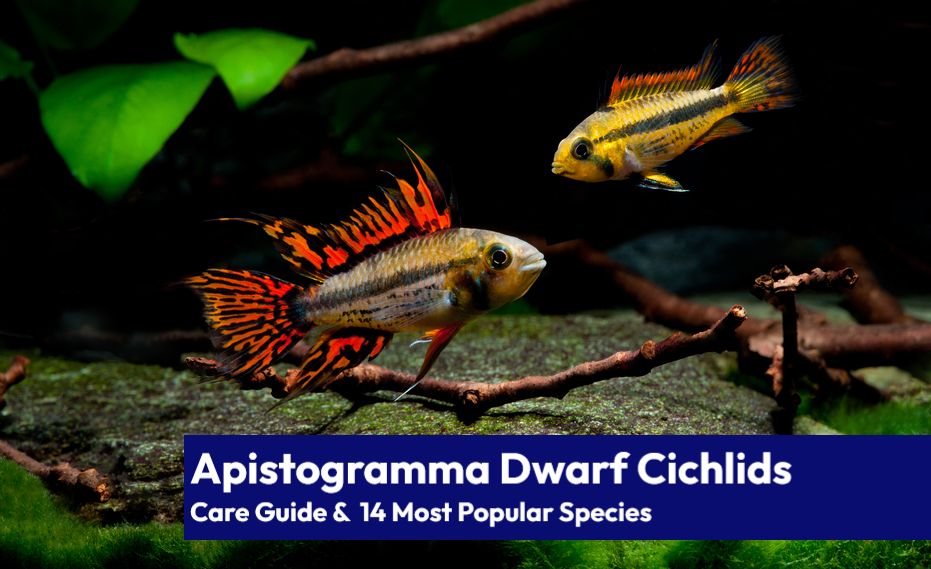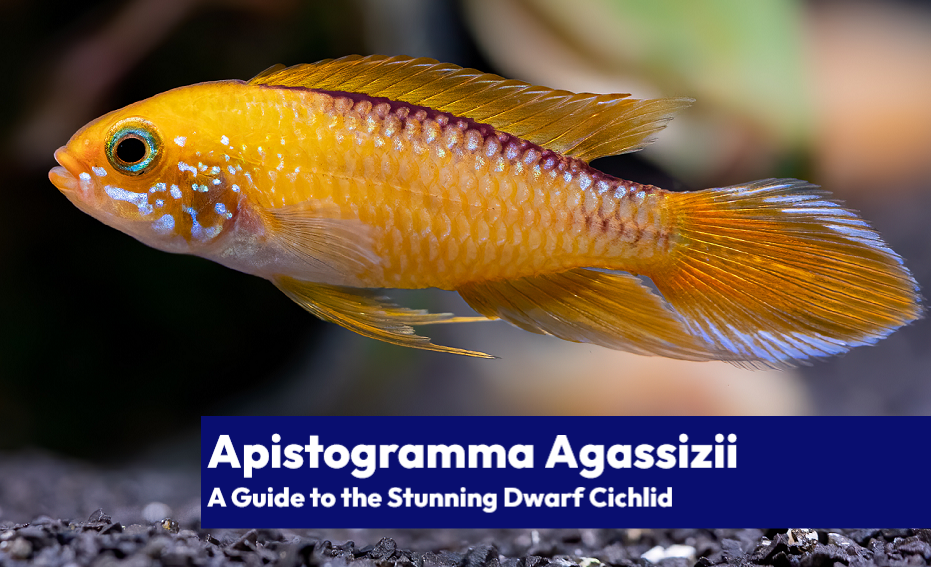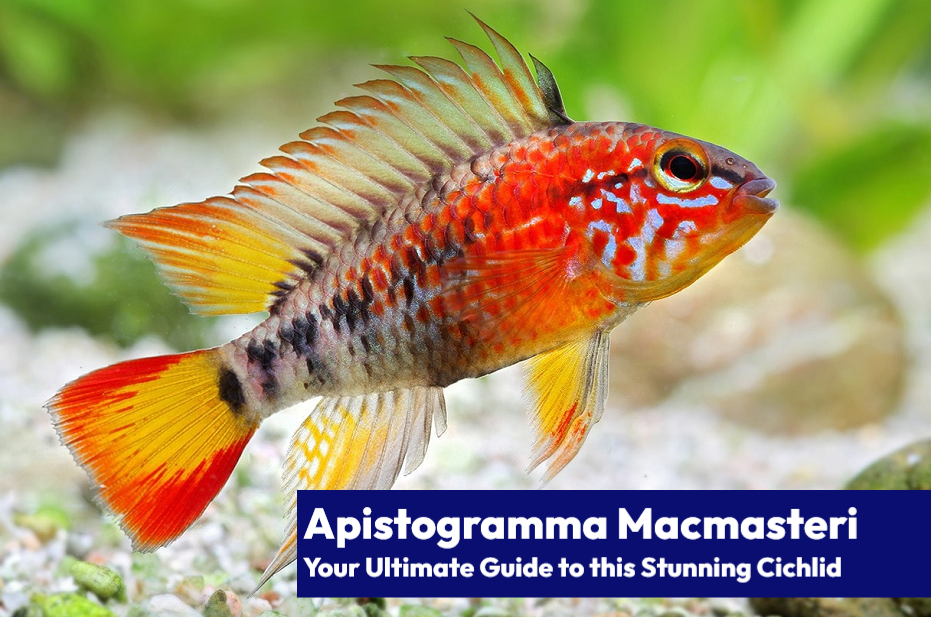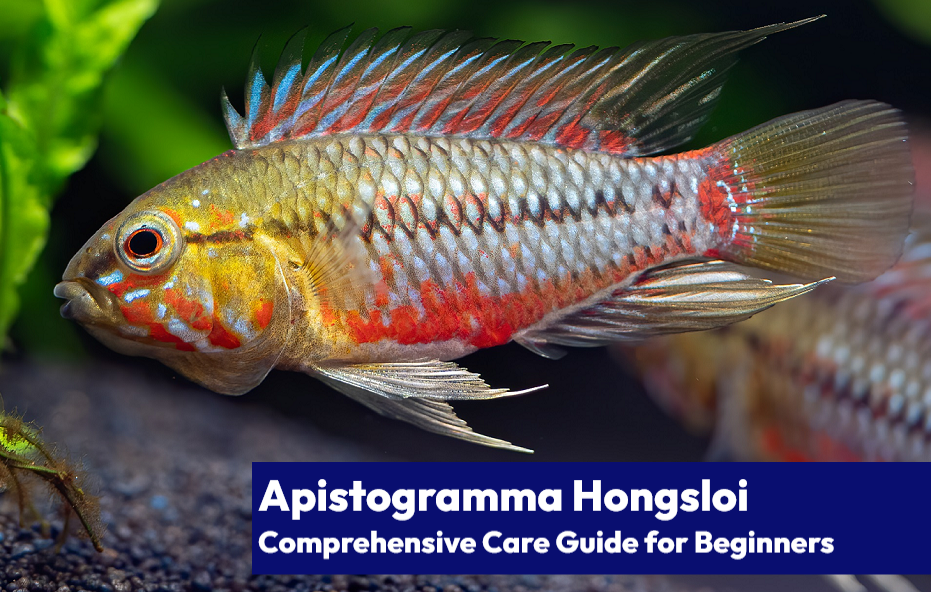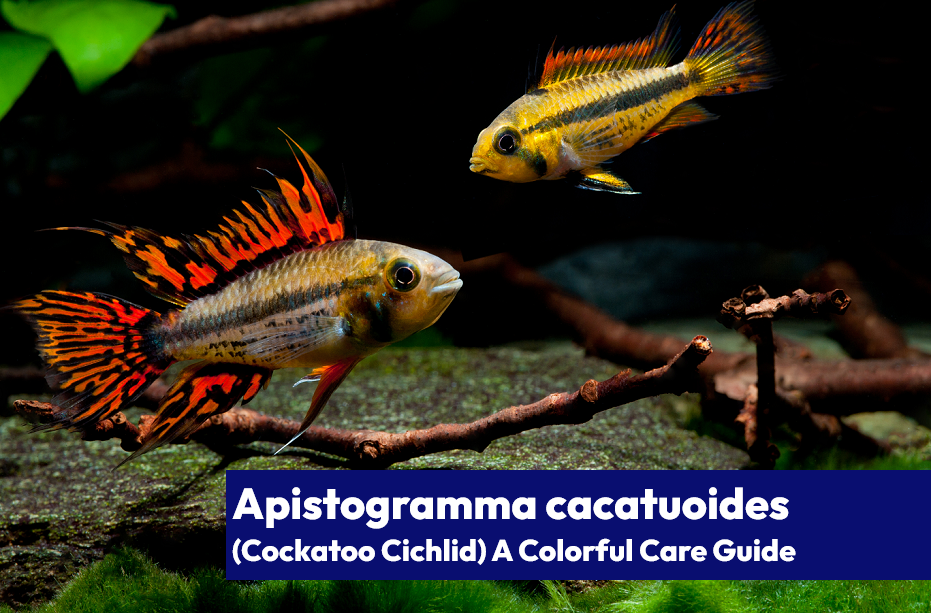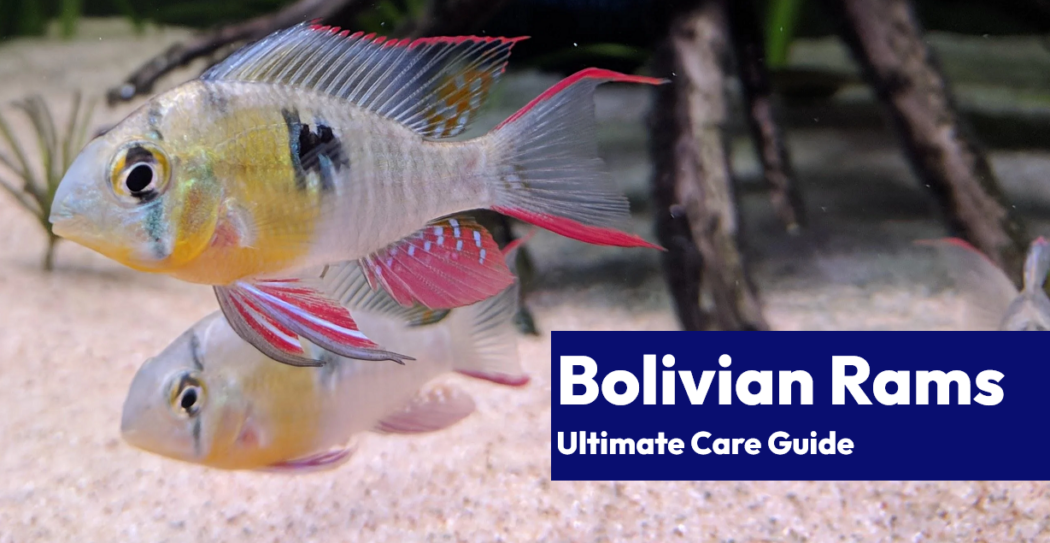The Kribensis cichlid, also known as the Purple Cichlid, is a stunning and vibrant species that is sure to light up any aquarium. With its vibrant colors, playful personality, and ease of care, it’s no wonder why this fish is a popular choice among hobbyists. This West African species, scientifically known as Pelvicachromis pulcher, is a great option for both beginner and experienced aquarium enthusiasts.
The krib, as it’s affectionately known, gets its name from its former scientific name, P. kribensis. The modern name, P. pulcher, translates to “beautiful belly fish,” and it’s easy to see why. During breeding season, the female’s belly turns a vibrant cherry red, making it a standout in your tank. In this article, we will dive into the world of the Kribensis and explore all aspects of their care, from their appearance, lifespan, and housing requirements to their behavior and breeding habits. So, let’s jump in and discover the secrets of this underwater treasure!
| Care Data | Description |
|---|---|
| Scientific Name | Pelvicachromis pulcher |
| Adult Size | 4-5 inches (10-13 cm) |
| Life Span | 5-8 years |
| Water Temperature | 72-79°F (22-26°C) |
| Water Hardness | Soft to slightly hard (5-15 dGH) |
| pH Level | 6.0-7.0 |
| Tank Size | 10 gallons (37 L) minimum for a breeding pair |
| Diet | Omnivorous |
| Tank Set-Up | Planted aquarium with caves, rocks and driftwood |
| Water Changes | 20-30% weekly |
| Compatibility | Peaceful, best kept with other peaceful fish |
| Breeding Requirements | Higher temperatures (80-82°F or 26.6-27.8°C) and water hardness (10-20 dGH) in separate breeding tank |
Appearance
Unique Features of Female Kribensis
Female Kribensis are known for their short and rounded fins, as well as a broad yellow band that spans across the top of their dorsal fin. These fish are much smaller in size compared to their male counterparts and have a more rounded belly that turns a brilliant shade of red or purple when they are ready to spawn.

The Majestic Male Kribensis
Male Kribensis, on the other hand, are larger, longer, and thinner, with fins that end in sharp points. Although they are less brilliantly colored than the females, they still have their own charm, especially with their distinctive fins and overall appearance.

Lifespan
The average lifespan of a Kribensis is around 5-8 years. With proper care, Kribensis have been reported to live even longer, up to 10 years!
Average Size and Growth Rate
The average size of a Kribensis cichlid is around 4 inches (10 cm) in length, with some reaching up to 6 inches (15 cm). They grow at a moderate rate, reaching their full size in about 2-3 years.
Tank Size
Kribensis cichlids are small and hardy, making them easy to care for even in small aquariums. A 10 gallon (37 L) tank is enough for one pair, but you’ll need more space if you want to keep them with other fish. They are generally peaceful but can become territorial during breeding season, so make sure to provide plenty of hiding spots and natural borders.

Water Parameters
Kribensis are native to soft and acidic waters in West Africa, and they prefer similar conditions in the aquarium. The ideal water temperature for a Kribensis is between 72-79°F (22-26°C), with a pH of 6.0-7.0.
Diet
Kribensis are omnivorous and will happily accept a variety of foods, including flake or pellet foods, frozen brine shrimp, freshly hatched brine shrimp, daphnia, mosquito larvae, bloodworms, and vegetables like zucchini.
To keep them healthy, feed them a variety of foods and provide some sinking options. When breeding, be sure to offer plenty of live foods.
| Food Option | Description |
|---|---|
| Brine shrimp | High in protein and easy to digest, brine shrimp can promote healthy growth and breeding in Kribensis. |
| Bloodworms | Bloodworms are a good source of protein and can enhance the coloration of Kribensis. They can also be fed to trigger breeding behavior. |
| Pellets | High-quality pellets are a balanced diet and provide essential nutrients, vitamins, and minerals. They can help maintain the overall health and well-being of Kribensis. |
| Frozen or live insects | Insects such as crickets and mealworms are rich in protein and can provide variety to Kribensis diet. They can also encourage natural feeding behavior. |
| Spirulina flakes | Spirulina flakes are high in protein, fiber, and antioxidants. They can enhance the immune system and promote overall health in Kribensis. |
| Daphnia | Daphnia is a good source of protein and can also help promote digestive health in Kribensis. |
| Algae wafers | Algae wafers can provide essential minerals and nutrients that Kribensis need for healthy growth and maintenance. They can also help improve the water quality of the tank. |
| Vegetables | Kribensis can benefit from blanched vegetables such as zucchini, peas, and spinach. These are a good source of fiber and can help promote healthy digestion. |
Housing Requirements
Kribensis are best housed in a well-planted tank with plenty of hiding places and caves. They also require a filter to provide adequate filtration. They appreciate some floating plants to diffuse the light and create a shaded area in the tank.

Kribs also enjoy hiding spots, so include a cave for them to retreat to. As diggers, it’s best to use sand or fine gravel as substrate to prevent injury.
Provide each fish with one or two caves, made from stable rock formations, flowerpots, plastic pipes, coconut shells, or driftwood. The tank should also have an area for open swimming. Kribensis prefer fine, dark-colored gravel, but they are not destructive to vegetation and may burrow, so keep an eye out for uprooted plants. These fish are undemanding and can tolerate a variety of water conditions, making them a great choice for beginner fish keepers.
Behavior and Temperament
Kribensis are peaceful and playful fish that are well-suited for a community tank. They can become territorial during breeding, but otherwise, they are a peaceful species.
Breeding
Kribensis are relatively easy to breed, and with the right conditions, they will breed regularly. Below is an in-depth guide to get you informed on breeding these cichlids.
Getting Started
To begin, you’ll need a pair of Kribs. If you already have a breeding pair, you’re all set! If not, head to your local fish store and choose two young, healthy, and robust Kribs. It’s best to select a male and female that are close in size and color, as this will increase the chances of successful breeding. Keep in mind that female Kribs tend to mature faster, so it’s best to choose specimens that are at least six months old.
Sexing Kribensis: Male vs Female
Like other Pelvicachromis species, the Kribensis cichlid is sexually dimorphic. Males have pointed pelvic, dorsal, and anal fins, while females have more rounded fins. Males are larger, lack the gold sheen on their dorsal fin, and have a more elongated tail.
In the wild, the Kribensis cichlid forms polygynous harems, but in captivity, they form monogamous pairs. The species is a secretive cave spawner, but there is limited information on their reproductive biology in the wild.
Once you have your pair, give them a tank of their own. A 20-gallon or larger tank is ideal, and it’s important to avoid adding any other fish, as Kribs can become very territorial and aggressive while breeding. Be sure to provide several caves for the pair to choose from, and decorate the tank with fine gravel (under 3 mm) and plants to mimic their natural habitat.
Water Conditions for Breeding
Kribs prefer slightly soft water with a pH of 7.0 and a temperature of 80 degrees. To create the ideal breeding environment, make sure to maintain stable water conditions and avoid abrupt temperature changes. Frequent water changes are also important to keep the water clean and healthy for the growing fry.
Breeding
As you condition the pair with a generous diet of live foods, you’ll notice their colors intensifying in preparation for breeding. The female will usually initiate the courtship by displaying her brightly colored abdomen and performing a series of body movements to attract the male.
In captivity, artificial caves are readily accepted as breeding sites, which are excavated before egg-laying. The eggs are adhesive and are laid in rows of about 10 on the upper surface of the cave, producing a clutch that ranges in size from 40 to 100. Both the male and female provide active brood care, with the female primarily responsible for fry care and the male primarily involved in territorial defense.
In a few days, the fry will hatch and become free-swimming. At this stage, it’s important to feed them small amounts of freshly hatched brine shrimp or finely crumbled flake food several times a day. The parents will also help to care for the fry, but be prepared for one parent to take on the role of primary caregiver and become aggressive towards the other. If this happens, it’s best to remove the secondary parent to another tank to avoid fights.

In 2-4 weeks, the fry will reach approximately half an inch in size and should be separated from the parents. At this point, the parents will be ready to breed again and can be returned to their breeding tank.
Tankmates
Kribensis are best kept with peaceful species that are similar in size. Avoid keeping them with aggressive or larger fish that may bully them.
Kribs can be kept with other passive fish such as dwarf cichlids, tetras, and small barbs, but avoid slow-moving species with long fins as kribs may become fin nippers.
| Fish Name | Description |
|---|---|
| Bolivian Ram | A peaceful cichlid species that is active, colorful and easy to care |
| Cherry Barb | A small, colorful and peaceful species that adds movement to the tank |
| Swordtail | A hardy, peaceful and active species that can live with Kribensis |
| Honey Gourami | A small and peaceful fish that is great for community tanks |
| Cardinal Tetra | A small, schooling fish that adds color and movement to the tank |
| Bristlenose Pleco | A hardy and peaceful bottom-dweller that helps to keep the tank clean |
| Harlequin Rasbora | A small and peaceful species that adds color to the middle of the tank |
| Siamese Algae Eater | A hardy, active and peaceful bottom-dweller that eats algae |
| German Blue Ram | A peaceful cichlid species that adds color and movement to the tank |
| Guppy | A hardy and peaceful species that adds color and movement to the tank |
| Zebra Danio | A small and active species that adds movement to the tank |
| Neon Tetra | A small and peaceful species that adds color and movement to the tank |
| Corydoras Catfish | A peaceful bottom-dwelling species that adds variety to the tank |
| Black Skirt Tetra | A peaceful species that adds color and movement to the tank |
| Pearl Gourami | A peaceful and colorful species that adds interest to the tank |
Note: When choosing tankmates for Kribensis, it is important to consider their size, temperament, and compatibility with the water parameters of the tank. Always research the specific needs of each fish species to ensure they are compatible with Kribensis.
Types
The genus Pelvicachromis is home to many amazing species, not just the well-known P. pulcher. While you may come across the correct names at your local fish store or on price lists, sometimes you may encounter them under incorrect labels. Don’t worry, with a little research and helpful information, you’ll be able to spot and care for some of the most common species and variants. In additional to related species, there is also an Albino variant of the popular Pelvicachromis Pulcher, depicted below.

The albino form is incompletely dominant and retains red and yellow pigments, as well as patches of melanin in the dorsal and caudal fin.
Pelvicachromis Rubrolabiatus: The Red-Lipped Beauty

Described in 2004, Pelvicachromis rubrolabiatus is a recent addition to the Pelvicachromis genus. This species is known for its red lips and can grow bigger than other species in its genus. Male P. rubrolabiatus is easy to spot with its seven dark vertical bars on the body and lack of coloration on its fins.
This species originates from the Kolenté River basin in Guinea, where it lives in soft, acidic waterways surrounded by forests. In captivity, it’s important to keep the water soft and the pH value below 6.0. P. rubrolabiatus is an omnivore and needs a balanced diet of green and meaty foods. Be warned, this species can be fairly aggressive.
Pelvicachromis Subocellatus: The Yellow-Cheeked Kribensis

The yellow-cheeked kribensis (Pelvicachromis subocellatus) was described in 1872 and is a very attractive species. However, there have been a lot of mix-ups and mislabeled fish in the aquarium trade, so older accounts about this species may not be reliable.
Female P. subocellatus is more colorful than the male and has bright yellow cheeks, a white reflective pattern on her dorsal fins, and a pinkish red belly bordered by blackberry blue stripes during spawning. The male also has yellow cheeks, but the shade is more pastel and lacks spotting.
This species is found in Gabon to Congo in Western Africa and can live in both soft and hard water with a pH value of 6.0 to 8.0. It’s a hardy and less aggressive species that is well suited for community and species tanks. A densely planted aquarium with plenty of hiding spots is recommended.
Pelvicachromis Taeniatus: The Colorful Kribensis

Pelvicachromis taeniatus is an active and beautiful species that is relatively easy to keep and breed. This species is peaceful enough to be kept in a community aquarium with other non-violent species.
P. taeniatus is one of the most colorful members of its genus and comes in a variety of color morphs. It is found in coastal Nigeria, Cameroon, and Equatorial Guinea and lives in still and slow-moving streams and rivers surrounded by forests. Soft and acidic water is recommended, along with a temperature of 72° to 79°F (22° to 26°C) and a pH value of 6.0.
P. Taeniatus does not like strong water movement or bright light, so it’s best to include floating plants to shade the aquarium. Caves are also necessary for this species to feel happy and healthy. A varied omnivore diet is best, with plenty of veggies and occasional servings of live or frozen meaty foods.
Diseases & Illness
| Illness | Symptoms | Treatment |
|---|---|---|
| Swim bladder disorder | Floating or sinking abnormally, trouble swimming, bloated appearance | Maintain good water quality, limit overfeeding, try fasting for a few days, possible surgical intervention. |
| Fin rot | Frayed or deteriorating fins, redness or bleeding at the base of the fins | Improve water quality, use an antibiotic treatment such as Maracyn or Maracyn-Two, keep the tank clean. |
| Bacterial infection | Red streaks on the body, ulcers, cloudy eyes, lethargy | Use an antibiotic treatment such as Kanamycin, Nitrofurazone, or Erythromycin, maintain good water quality, keep the tank clean. |
| Ich | White spots on the skin, scratching, flashing, loss of appetite | Treat with a specific parasite medication, such as malachite green or formalin, and maintain proper water temperature. |
| Columnaris | Cotton-like growths on the skin, frayed fins, ulcers, cloudy eyes | Treat with a broad-spectrum antibiotic, such as Kanamycin or Nitrofurazone, maintain good water quality and reduce stress. |
History & Origin
The Kribensis cichlid is native to the rivers and streams of West Africa, specifically in the countries of Nigeria and Cameroon. This species inhabits slow-moving waters and is known to occupy areas with dense vegetation, providing ample hiding spots and foraging opportunities. Despite its widespread distribution, the Kribensis was not formally described until 1901, when it was first scientifically named by Belgian zoologist George Albert Boulenger.

Also known as the purple cichlid, niger cichlid, palette cichlid, rainbow krib, pink kribensis cichlid, or king cichlid, Pelvicachromis pulcher is native to the drainage area of the Ethiope River in the Niger Delta. This species is able to thrive in different water conditions, making it a hardy option for aquarium life. In the wild, kribs are found in environments with a range of water temperatures (75° to 79°F) and pH levels (5.6 to 6.9).
The Kribensis cichlid also occurs outside of its natural range in Hawaii, USA as a result of releases in the ornamental fish trade. This species lives in both slow and fast-moving water, but only in areas with patches of dense vegetation. It shares its habitat with other fish species, including other cichlids and Brycinus longipinnis and Aphyosemion species.

In the wild the Kribensis cichlid is preyed upon by predators such as Hepsetus odoe, Hydrocynus forskahlii, and Lates niloticus. In their native habitat Kribensis cichlids have been observed digging, defending, and sheltering in caves beneath plants, which are also used for breeding.
In the early 20th century, the Kribensis gained popularity in the aquarium hobby due to its attractive colors and interesting behaviors. This species is known for its bright purple or red belly and yellow or green dorsal fin, making it a visually stunning addition to any aquarium. Additionally, the Kribensis is known for its unique breeding behaviors, where males build and defend nests for their eggs and fry. This behavior, combined with its vibrant colors, made the Kribensis a highly sought after species in the aquarium hobby.
In the decades that followed, the Kribensis cichlid became a staple species in the aquarium trade, with captive-bred individuals being readily available in pet stores and online retailers. As the hobby grew, so did the knowledge and understanding of the Kribensis, with aquarists learning more about its natural history and captive care requirements. This led to the development of more specialized aquarium setups, designed specifically to meet the needs of this species.

Despite its popularity in the aquarium hobby, the Kribensis remains relatively unknown in the wild, with limited scientific research being conducted on its natural history and ecology. Contrary to what some aquarium literature suggests, a study of wild Kribensis cichlids showed that their main food items are diatoms, green algae, pieces of higher plants, and blue-green algae. Invertebrates are a relatively uncommon food source.
Taxonomy
| Taxonomic Rank | Name |
|---|---|
| Kingdom | Animalia |
| Subkingdom | Bilateria |
| Infrakingdom | Deuterostomia |
| Phylum | Chordata |
| Subphylum | Vertebrata |
| Infraphylum | Gnathostomata |
| Superclass | Actinopterygii |
| Class | Teleostei |
| Superorder | Acanthopterygii |
| Order | Perciformes |
| Suborder | Labroidei |
| Family | Cichlidae |
| Genus | Pelvicachromis |
| Species | Pelvicachromis pulcher (Boulenger, 1901) – Purple cichlid, Rainbow kribensis |
Frequently Asked Questions
Q: Are Kribensis aggressive?
A: Kribensis are generally not considered to be aggressive fish. They can become territorial when breeding, but otherwise, they are peaceful and can coexist well with other peaceful fish.
Q: Can Kribensis live with African cichlids?
A: Yes, Kribensis can live with African cichlids, but it’s important to note that African cichlids are often more aggressive than Kribensis and may bully or harm them. It’s best to keep them with similarly sized, peaceful fish.
Q: Can Kribensis live with guppies?
A: Yes, Kribensis can live with guppies, but it’s important to provide enough space for both species. Guppies are much smaller than Kribensis, so they may be at risk of being chased or eaten by the larger fish if they are kept in a too-small tank.
Q: How big do Kribensis cichlids get?
A: On average Kribensis cichlids can grow up to 4 inches (10 cm) in length, with some growing up to 6 inches (15 cm).
Q: How long do Kribensis eggs take to hatch?
A: Kribensis eggs typically hatch in 2 to 3 days.
Q: How many Kribensis in a tank?
A: It’s recommended to keep at least 4 to 6 Kribensis in a tank to ensure they have enough space and social interaction. The size of the tank will depend on how many fish you want to keep, but a minimum of 30 gallons is recommended for a small group of Kribensis.
Q: How often do Kribensis breed?
A: Kribensis can breed frequently, with a female able to lay eggs every 4 to 7 days.
Q: Can Kribensis live with rams?
A: Yes, Kribensis and rams can be kept together as long as the tank is large enough to provide enough space for both species and has a peaceful community.

Tim Priest, a renowned aquarium expert with over 15 years of experience in aquatic gardening and fish education, is dedicated to helping enthusiasts create stunning and thriving aquatic environments. As the founder of LearnTheAquarium.com, Tim shares his wealth of knowledge, passion, and expertise through engaging articles, educational resources, and personalized advice.
Discover the secrets to creating captivating underwater landscapes and maintaining healthy aquatic ecosystems. Join Tim on an exciting journey and let your aquarium adventure begin!

